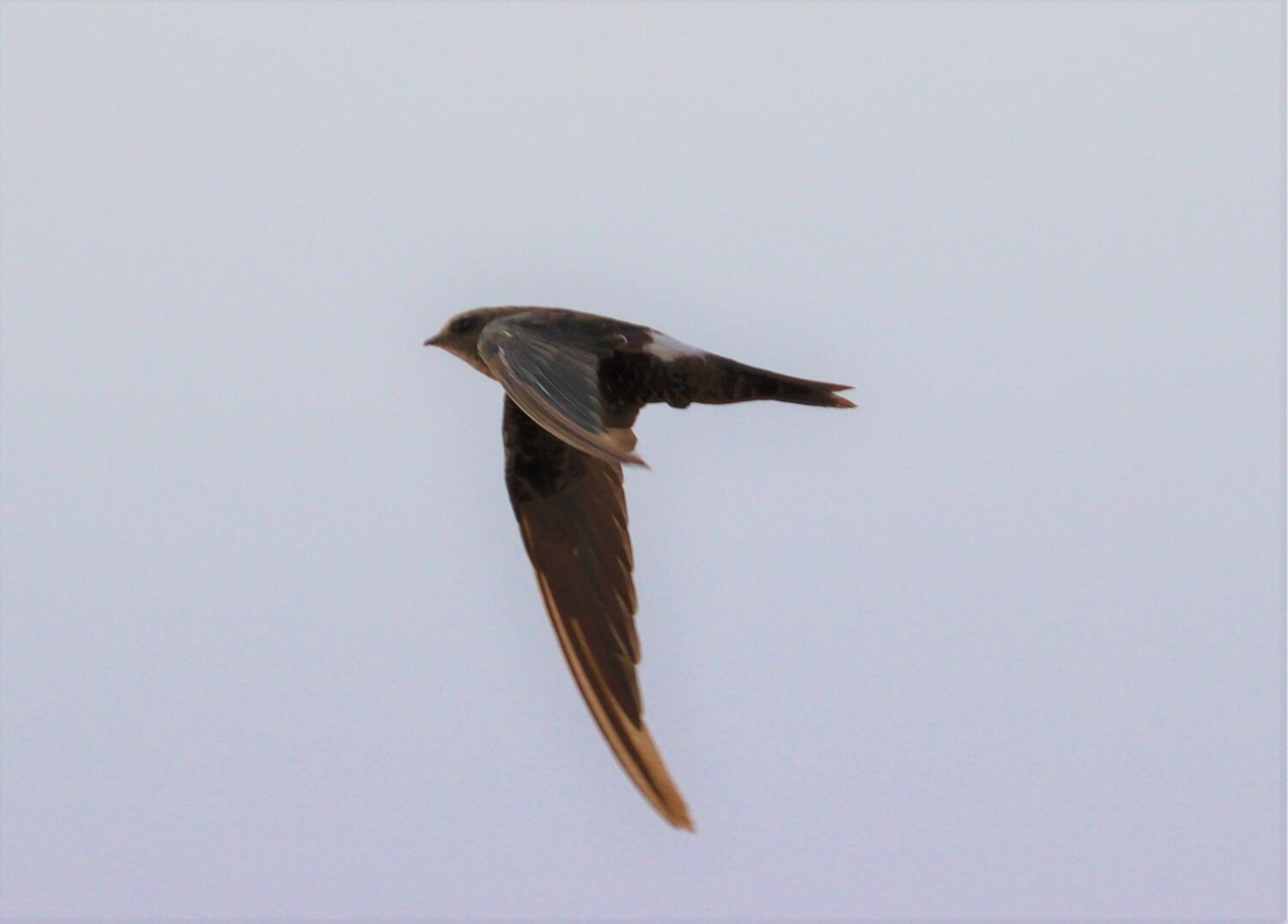Pacific Swifts
These photos are nothing special but the bird is. It’s a Pacific Swift, sometimes called a Fork-tailed Swift (not a weird looking budgie). Phil was horrified when I pronounced his photos “not really good enough to keep”. He explained how he asked our daughter to stand watch and call out “Now!” when the birds were in range. He had also just discovered how to use the “burst” setting on the camera the previous day. Hundreds of photos … some even had a bird in them! At least you can see the diagnostic scalloped markings on the flanks and bellies.
Reading more about the Pacific Swift, I think it is quite acceptable to share blurry photos of this bird. They are pretty much in constant and fast flight, high up in the sky, and they seldom roost. Their scientific name Apus is derived from a Greek word meaning “without feet” because their little legs are really only used at nesting time. They feed exclusively on insects caught during flight, and drink, bathe, mate and even sleep on the wing! Their bodies are aerodynamically designed machines. (1, 2). Scientists using electronic tracking tags found Alpine Swifts in the non-breeding season did not land for 200 days straight! (7)
There were only 50-70 in the flock Phil saw, but there are reports of flocks numbering in the thousands. In Queensland “three car-loads of bird observers contributed to an estimate of 215,000 Fork-tailed Swifts seen on 21 January 2012” (3). The typical height for feeding is around 300 metres (1) but they have been reported at 1000 metres or more and their blood is adapted to such low oxygen environments. At these heights many of the birds would be too high to be seen without binoculars or a spotting scope (3).
Swifts are a migratory species, appearing in Australia in early Spring after nesting in colonies in eastern Asia. Because they are aerial, they don’t favor any particular habitat and can be seen at random locations across Australia during the warmer months. Not quite random, Swifts need to forage in open areas with lots of “aerial plankton”, that is air-borne insects and spiders. They have a little bill with a wide gape which helps them to hoover up insects as they fly, like a little air-borne whale!
Wikipedia suggests that the Pacific Swift “often forages near low-pressure areas, which serve both to raise insects from the ground and to give the swifts additional lift.” This summary from the 2018 edition of Mildura Birdlife’s “Rainbowbird”, supports this and matches our weather observations from 25th January 2020:
“We have had a series of storm-fronts or upper-level troughs passing through our district in late-January, early-February. On 22nd of January several of Mildura BirdLife’s members saw Fork-tailed Swifts flying over parts of Sunraysia during the day. This day was quite humid with cloud covering, coinciding with a weather front passing through. This combination seems to attract the birds to visit our area occasionally – seemingly, perhaps, around once per year.” (4)
The coolest things about Swifts are their navigational skills. Some clever scientists have used weather radar data to show that Common Swifts ascend to higher elevations at both dawn and dusk. These ascents are carefully timed to occur in the twilight because this best allows them to profile the atmospheric boundary layer (check the weather) as well as detect distant landmarks to use as cues to navigate. (5)
The weirdest thing about Swifts is the way they gather nesting material, yep, on the wing. They search for air-borne detritus like bits of plants and other birds’ feathers, and have enlarged salivary glands which produce a glue-like saliva to gum it all together in the nest. In a sad reflection of the levels of air-borne litter, one observational study found a nest containing 40% plastic bags, and bizarrely a clump of aluminium coated, glass fibres which turned out to be radio-frequency chaff. This stuff is released into the atmosphere at high densities, sometimes for scientific experiments but generally as part of a military operation - “a defensive countermeasure designed to reflect radar waves and to obscure target equipment from enemy radar”. I never knew such a sneaky trick existed. “It is unsure whether the chaff is beneficial for breeding swifts as a new source of nest material, because the risk of exposure for swifts through ingestion or persistent contact has never been examined.” (7)
More information
Wikipedia - https://en.wikipedia.org/wiki/Pacific_swift
Prof Tarburton -http://www.swiftsoftheworld.info/
Prof Tarburton - “Swifts over the Hunter” -
https://www.hboc.org.au/wp-content/uploads/Hunter-Region-Swifts-The-Whistler-Vol-9.pdf
Mildura Birdlife “Rainbowbird” May 2018 - http://direct.birdlife.org.au/images/uploads/branches/documents/MDA_-_RB94.pdf
Twilight ascents by common swifts, Apus apus, at dawn and dusk: acquisition of orientation cues?https://www.sciencedirect.com/science/article/pii/S0003347212005556
Radio-frequency chaff in a nest of Pacific Swift Apus pacificus http://citeseerx.ist.psu.edu/viewdoc/download?doi=10.1.1.654.7434&rep=rep1&type=pdf
This Bird Can Stay in Flight for Six Months Straight https://www.smithsonianmag.com/science-nature/this-bird-can-stay-in-flight-for-six-months-straight-903069/?fbclid=IwAR0UxWHUJePplubfjHR1uZ0xXjMa_M9zA-6g59Sb6HvZYyaumI6KxJo2Rq0





